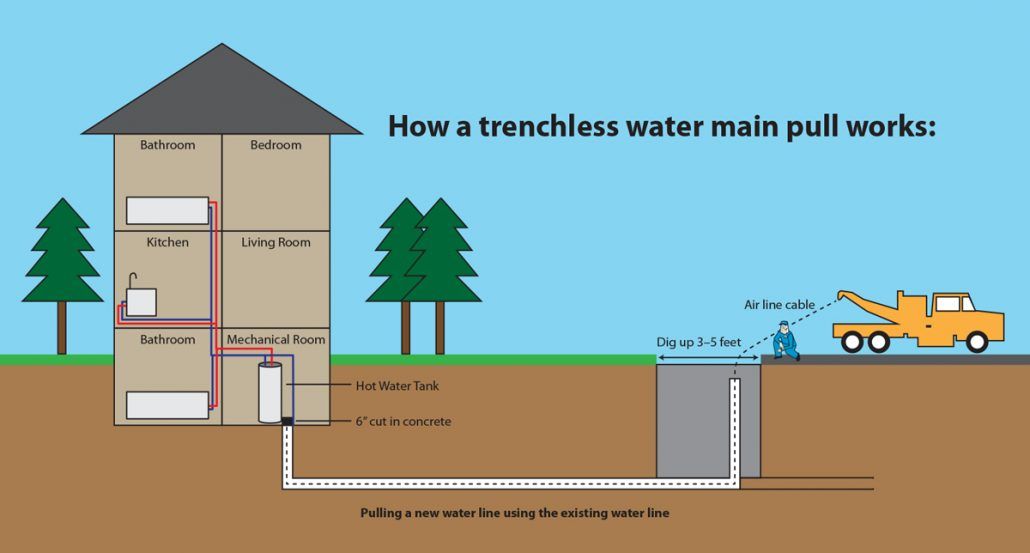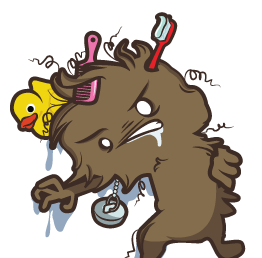Call today for a FREE QUOTE! 1-604-479-2232
TRENCHLESS WATER MAIN REPLACEMENT
Replacing your water main is something you should consider, especially if your house is older. Perhaps you’ve seen some signs that it should be done, such as a mushy lawn, a damp basement, or even water seeping through cracks in the foundation surrounding your home. If you think you’re in need of a water main replacement, but are concerned about the time it takes, the mess it makes, and how much it’s going to cost, then the JJ’s Plumbing experts are who you should get in touch with.
Our plumbers are licensed and fully certified, not to mention our customer service is second to none. We’re here to talk through the situation together and answer any questions you may have about the process before getting started. A trenchless water main pull requires zero—no—digging, which means your front lawn will remain in-tact. This is a huge bonus for going trenchless, and also saves you money.

What is a trenchless water main replacement?
Trenchless water main replacement is a method of replacing underground water pipes without digging a trench. This type of replacement involves using specialized techniques to access and replace the pipes without causing significant disruption to the surface above. Trenchless water main replacement is becoming more popular due to its potential benefits, such as reduced damage to landscaping and structures, faster completion times, and lower costs compared to traditional replacement methods.
Why Replace Your Water Main?
Your water main may use polybutyelene piping. If this is true, you will want to replace your water main before anything happens. Polybutyelene is a type of plastic resin that was used in water supply piping between the late 70s and mid-90s. If your house was built during this time, chances are, you have polybutyelene piping. So why repair it? Oxidants in water supplies, like chlorine, react with polybutyelene piping, which can cause them to flake and become weak/brittle. The result can be thin cracks in the piping, which reduce the strength of the water main. The piping system can end up failing without any warning, leading to flooding and damage to your household and property.
Another reason for replacing your water main is a burst or leak in the water line. It is best to replace the whole line, versus patching it.
Benefits Of A Trenchless Water Main Pull
- No digging required – your front yard will stay in-tact.
- Cost savings – less expensive compared to digging to replace the water main.
- Time savings – JJ’s Plumbing experts not only do the job right, but remain on schedule and aim to get your property back to normal as quickly as possible.
Signs to look for when suspecting a water main leak:
- Your lawn is mushy or wet.
- There is running water from the ground.
- There is water seeping through concrete cracks/your foundation.
- There is water leaking into your basement.
Contact JJ’s Plumbing immediately, or call the city so the water can be turned off from the city shut off.
Trenchless Water Main Replacement Steps
- JJ’s Plumbing will come over, investigate the leak and give a free, no-obligation quote.
- When the quote is accepted, we will book your appointment and make another visit to take care of business!
- JJ’s Plumbing will dig around the city shut off, at approximately 3-5 feet near the location.
- We will use a jackhammer to create a 6-inch diameter hole around the water line entering the house and main shut off (in the mechanical room).
- We will cut the water line below the main water shut off, and after the city shut off.
- Then, we will fish an airline cable through the existing water main from the inside to the exterior.
- We will attach the new water line and have a tow truck pull the new line through the existing line.
- We will reconnect the new water line to the city shut off, as well as to the interior plumbing.
- Finally, we will backfill the hole we created near the city shut off.
- There is minimal mess near your property with our trenchless water main pull!


